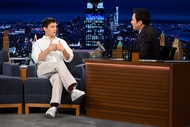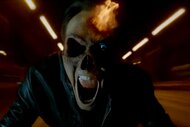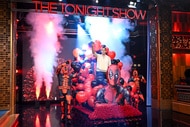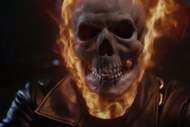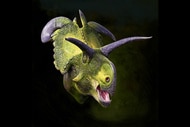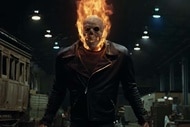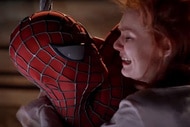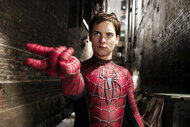Create a free profile to get unlimited access to exclusive videos, sweepstakes, and more!
What's the most iconic sound in comics? Marvels sound designer Mischa Stanton has the answer

Comics are the ultimate visual medium. They tell incredible, imaginative stories using nothing but the written word and still images, yet those pages of panels come alive in readers’ heads. Adapting a comic book into a movie makes sense — you can add movement and sound to those visuals. But what about a podcast? In an audio-only media, how do you give listeners that comic book experience without any visuals?
You call a sound designer.
“I create worlds within sound,” Mischa Stanton, the sound designer for Marvel and Stitcher's Marvels podcast, which is now streaming everywhere podcasts are found, tells SYFY WIRE. The series is an adaptation of the seminal 1994 graphic novel of the same name — specifically one part of the sprawling story, which offers a ground-level look at Marvel’s classic heroes. When Galactus attacks New York City in the 1960s, it’s up to the Fantastic Four to defeat the World-Eater, and it’s up to a group of non-powered reporters and photographers to figure out what happened.
Meanwhile, in the real world, it was up to Stanton to create the sounds of New York City under supervillain siege. Stanton, like any good sound designer, has a huge library of sounds that they can pick from, layering parts of their collection together to create the hustle and bustle of a city. Sometimes, though, they needed to act more like a foley artist, creating the sounds whole cloth.
“In the Marvels podcast, there’s a moment where they’re looking through a cardboard box full of old film reels. It takes place in the ‘60s,” Stanton explains. “I don’t have film reels and I don’t know if I’ve ever touched a film reel. I went rummaging through my kitchen and I borrowed my fiancé’s cake pans and shoved them into a cardboard box and they were pretty good [imitation.]”
Stanton spoke with SYFY WIRE about adapting a comic into an audio medium, the secrets to realistic web-slinging, and the most iconic sound in all of comics.
As a sound designer, what are the big challenges in adapting such a visual medium to a purely sonic one? Especially with Marvels, since it was illustrated by Alex Ross, a legendary hyper-realistic painter (he also did Kingdom Come on the DC side). How do you take away that incredible imagery and still make it pop? To still make it feel real?
What an excellent question and what an intimidating prospect. This is easily the biggest thing I’ve done in my entire career, so to come in and have [Marvel and Stitcher] be like “OK, we’re making an Alex Ross graphic novel but we’re taking all the visuals out of it,” and to replace that, was a big task.
I have a lot of experience working with the writer of the show, Lauren Shippen. I’ve been making a show that she created called The Bright Sessions and The AM Archives. So we have a long experience working together and talking to each other and collaborating and she has a sense of what she can write that will allow me to create a fully realized world. She worked really closely with the writer of the graphic novel, Kurt Busiek, to sort of make sure that the transition was smooth.
So I just dove in with all of my skills, knowing that Lauren wrote a script for me to make, and not necessarily something that had to exactly be what Alex Ross did on the page. That said whenever there was a hole in the script of oh we need something to happen here and we’re not exactly sure what I did end up going back to the book a few times and adapting specific panels that don’t necessarily even have any text over them. Specifically, there’s a moment in episode two where the city’s just chaos and one man is kind of wandering through it and a bike almost runs him over — that’s a direct translation from one panel of Marvels.
You need to make listeners feel like they’re in this New York that’s being attacked by Galactus, and then you also need to make the characters pop. So much of superheroes are these bright primary colors, and you recognize them by their costumes. You don’t have that in a podcast, so what are some of the tricks that you use to make the world feel real and the characters?
I start with sculpting each piece separately — the same way that you have different parts of the production of a comic book, sort of sketching the background details first. I have tracks that are just the wind and city background noise, and then from there I try to envision what the characters are doing in the moment and objects they’re interacting with and what makes what sounds in what order, timing-wise, to make it feel realistic and like people are really going through the motions.
While doing that, I try to focus on what formation is needed by the audience. What do they need to know what’s happening in the scene to understand what’s going on? And that comes from just living day-to-day and listening to my environment around me and a really thorough reading of the script.
Peter Parker appears in Marvels. How did you create the sound of Spider-Man’s web-shooters?
I went out and researched everything that Spider-Man sounds like these days, which is to say I rewatched Into the Spider-verse, I played the PS4 game, and actually Far From Home was in theaters when we were in production, and the Marvel executives I was working with sent me to go see it. I wasn’t actually gonna go see it until we were done but they were like “No, no, no. This weekend, go see it. It’s important that you go see it.” So I got a sense of what Spider-Man kind of sounds like these days.
And what I got is that it’s very modern, it’s very miniaturized, it’s very computerized. The web-shooters are tiny little gadgets and they’re characterized that way very intentionally. So when we were doing a story set in the ‘60s I said “how can we retro this up? How can we make it sound a little clunkier? Make it sound more like a physical process than a computerized little thingy.” So I went with ropes creaking and gas canisters expelling air and spooling of reels, fishing lines, and old film reels being unspooled very quickly. Those sorts of more physical elements kinda grounded it in the period.
What’s the most iconic sound in superhero comics? Spider-Man’s web-shooter (“thwip”) or Wolverine’s claws coming out (“snikt”)?
Those are my only two choices? I think it’s Nightcrawler’s “bamf.”
“Bamf” is a good one.
When I think of a sound effect, if it’s not from the 1960s Batman (“pow” or “sock”), I think it’s gotta be Nightcrawler, 'cause also I don’t know what other word describes that sound. It’s the onomatopoeia they wrote on the page and it persists even when you’re talking about other teleporters in other media.
Hear our full conversation with Mischa Stanton on SYFY WIRE's Who Won the Week podcast.
